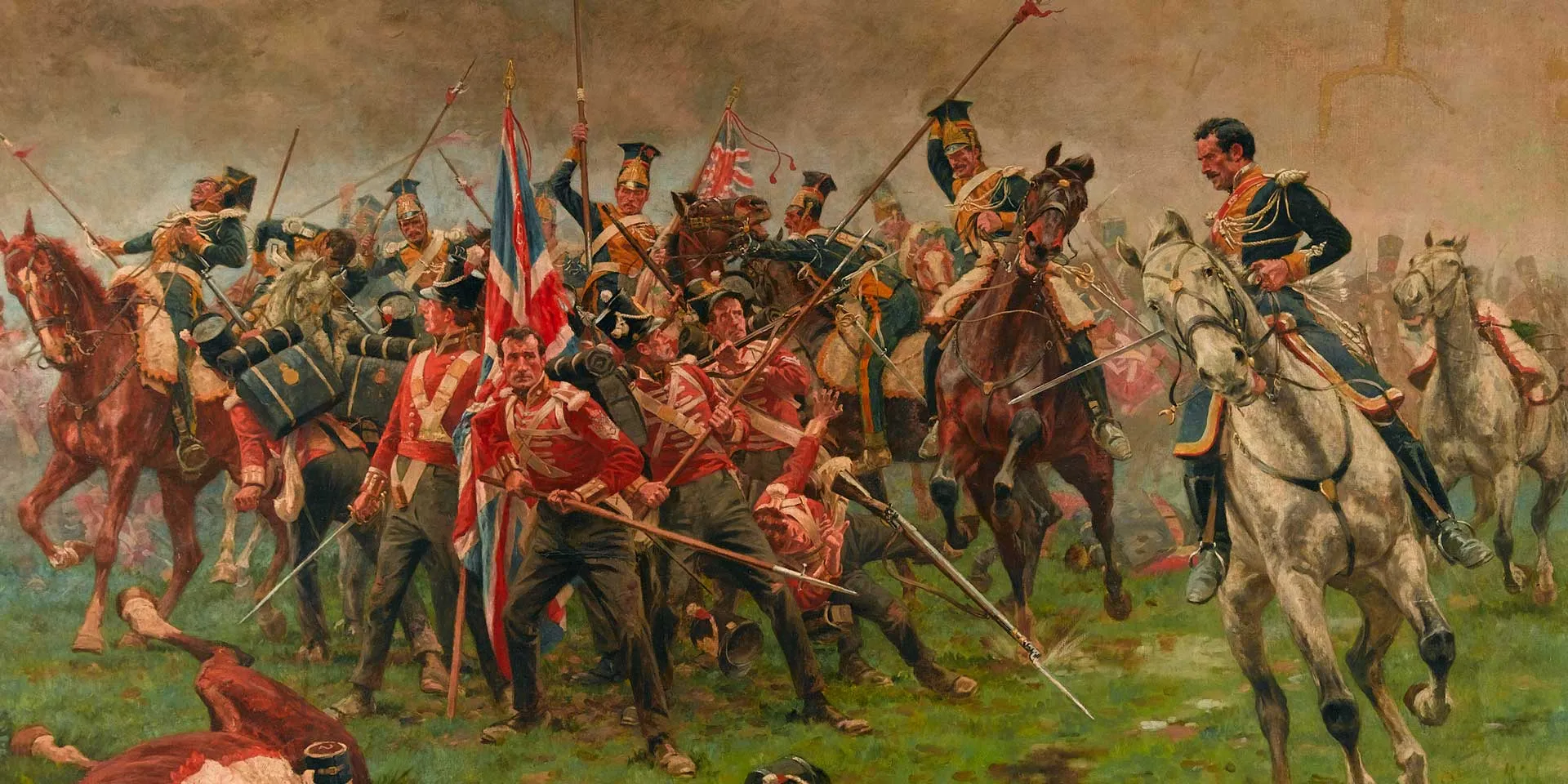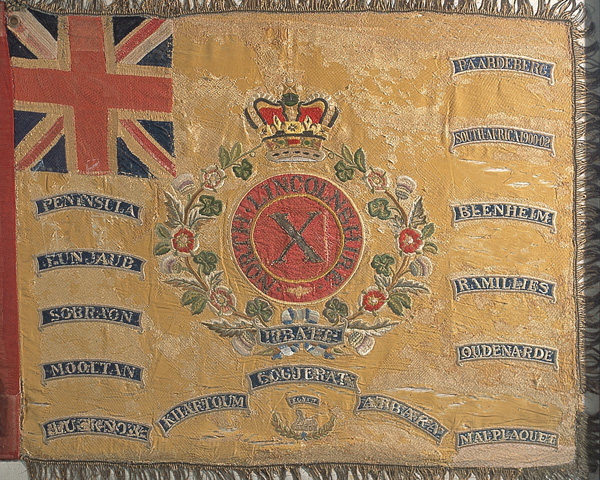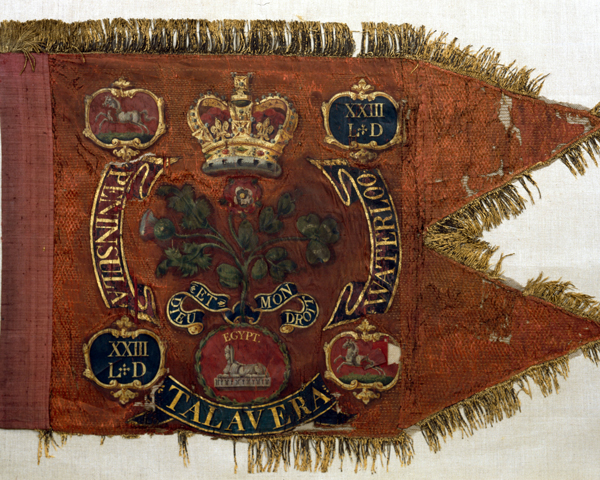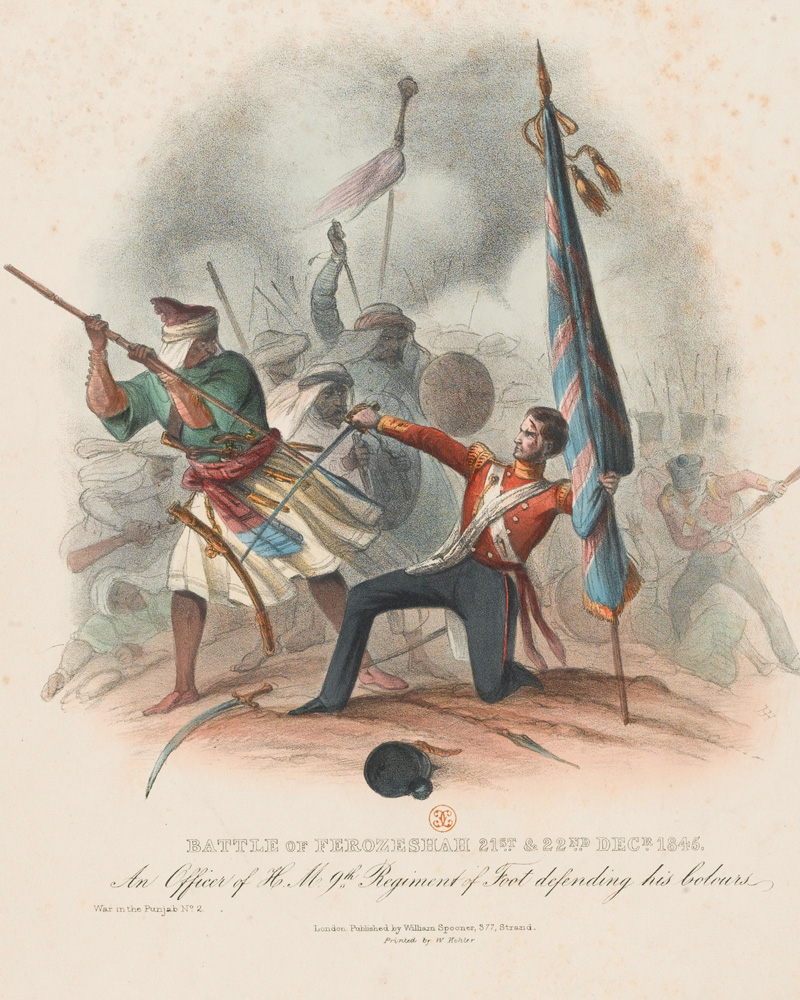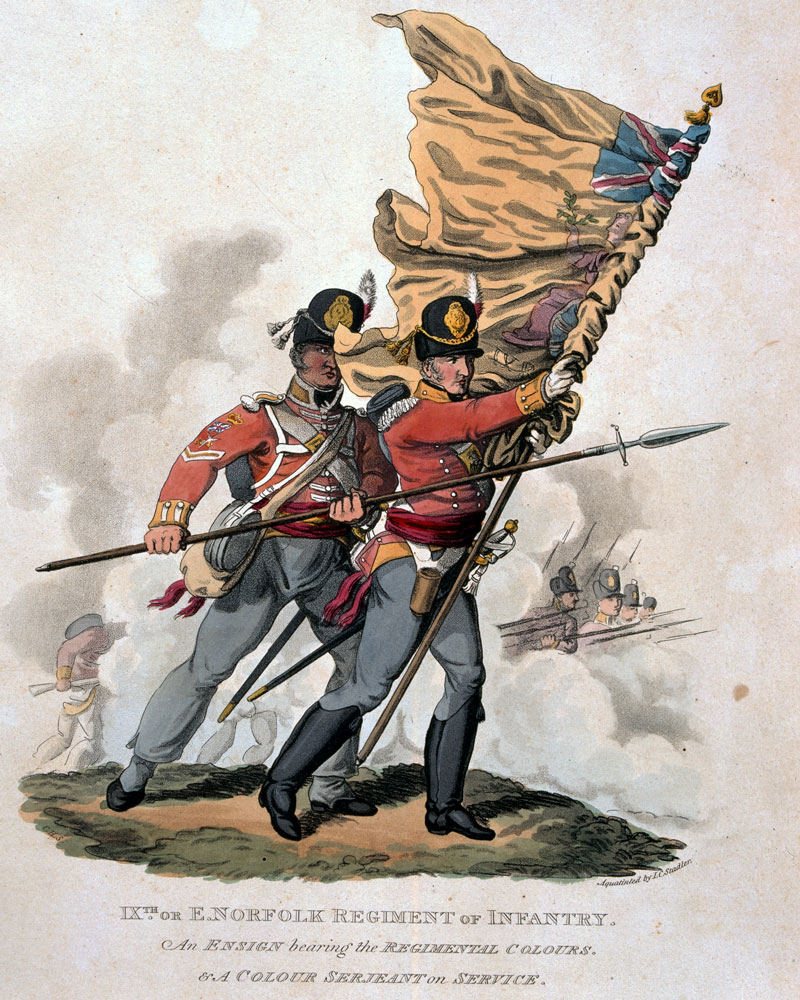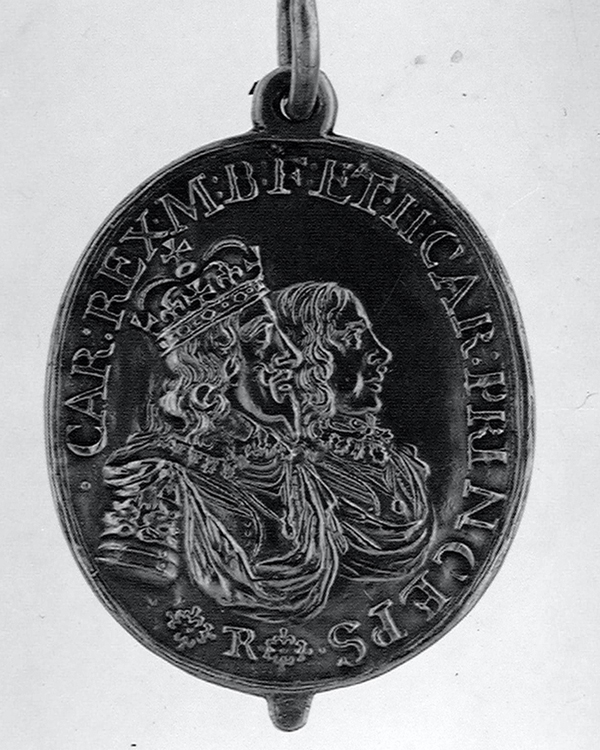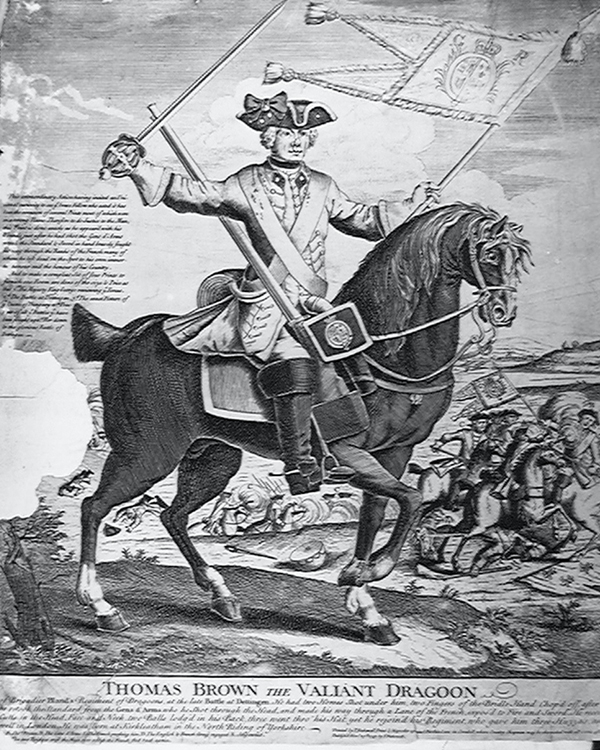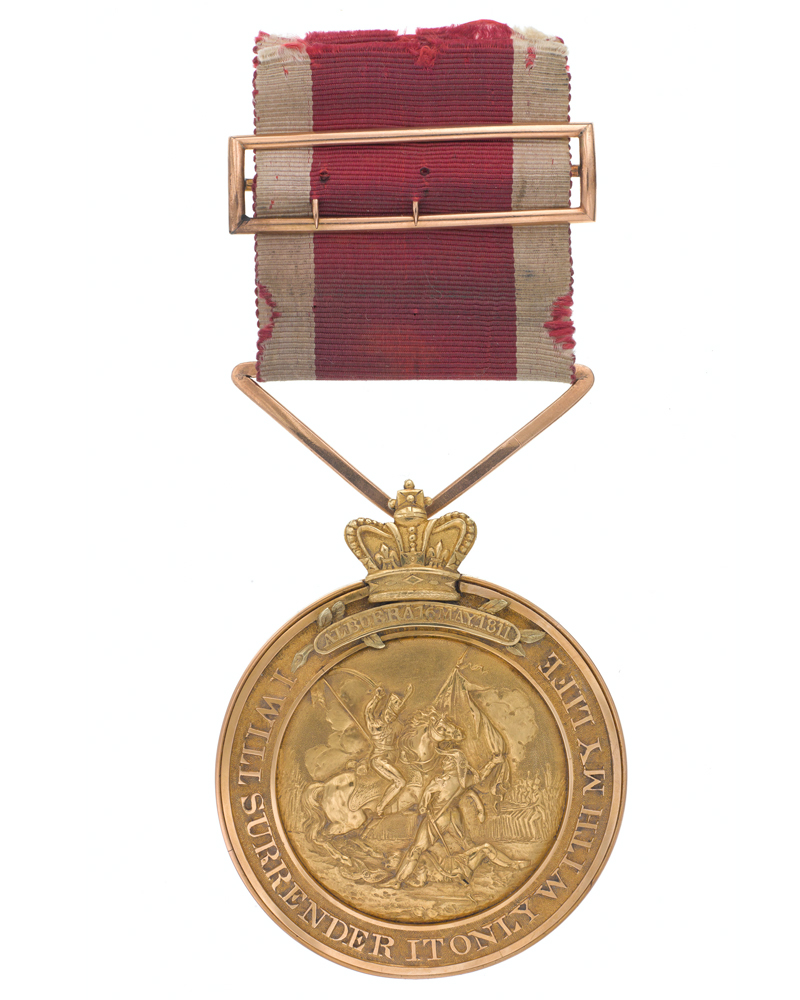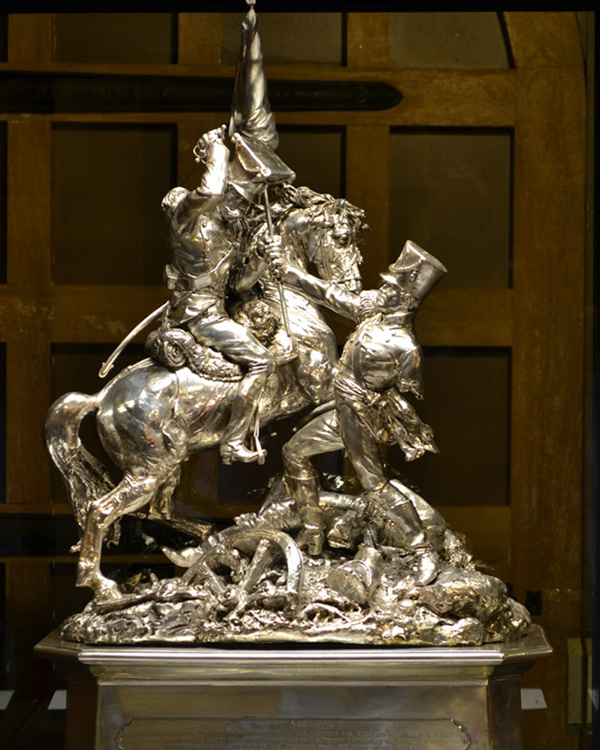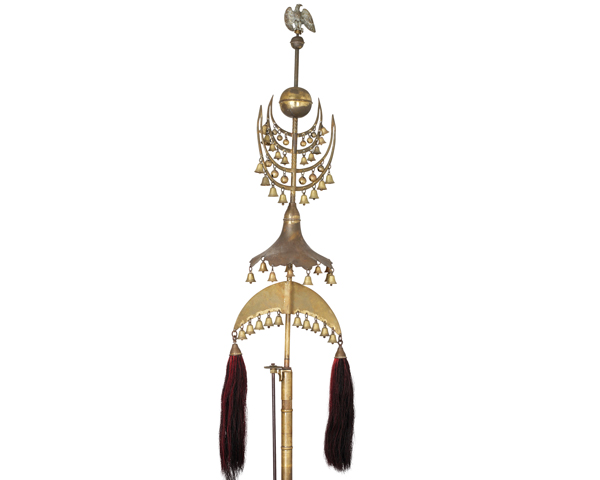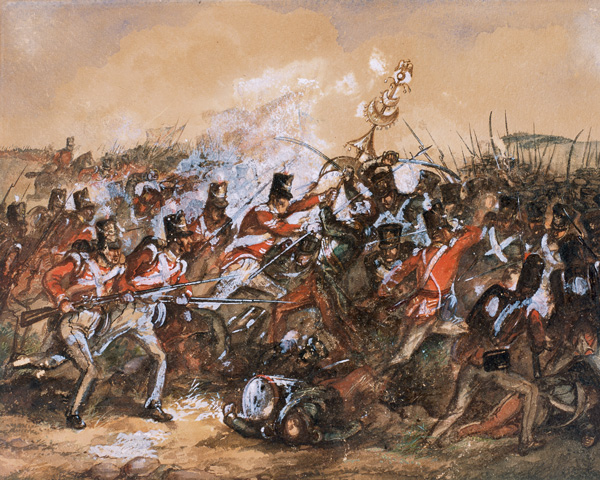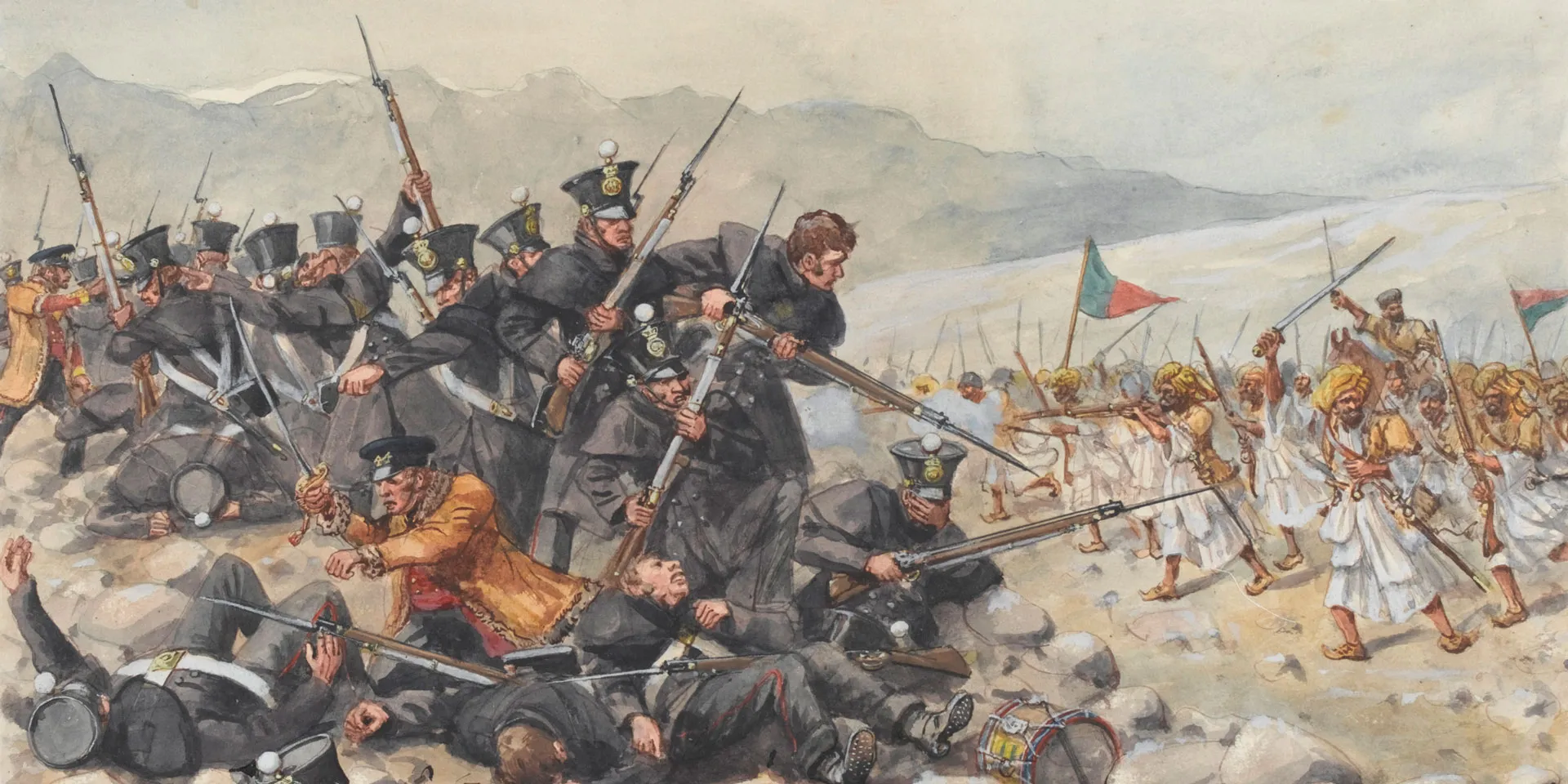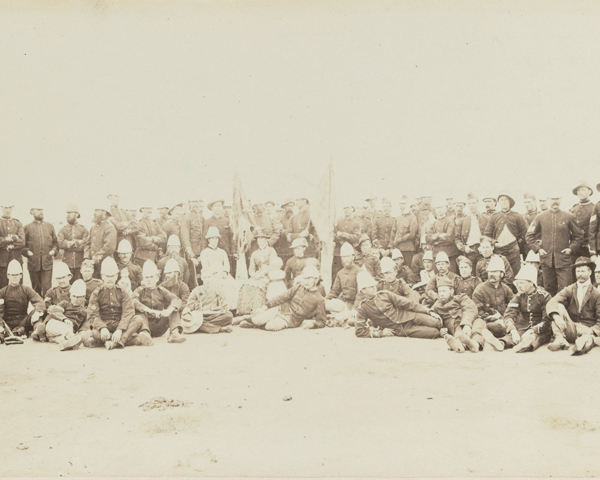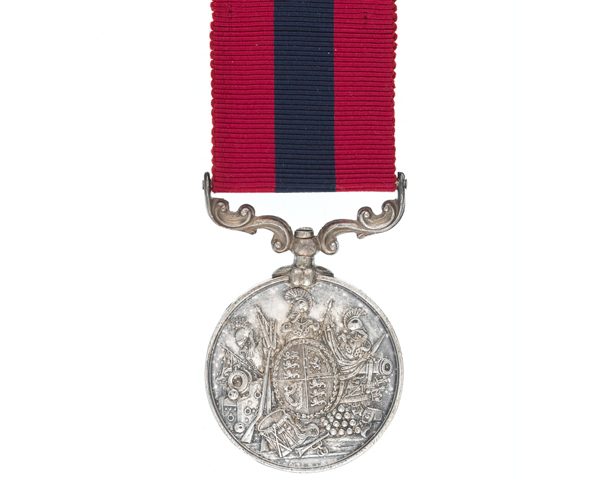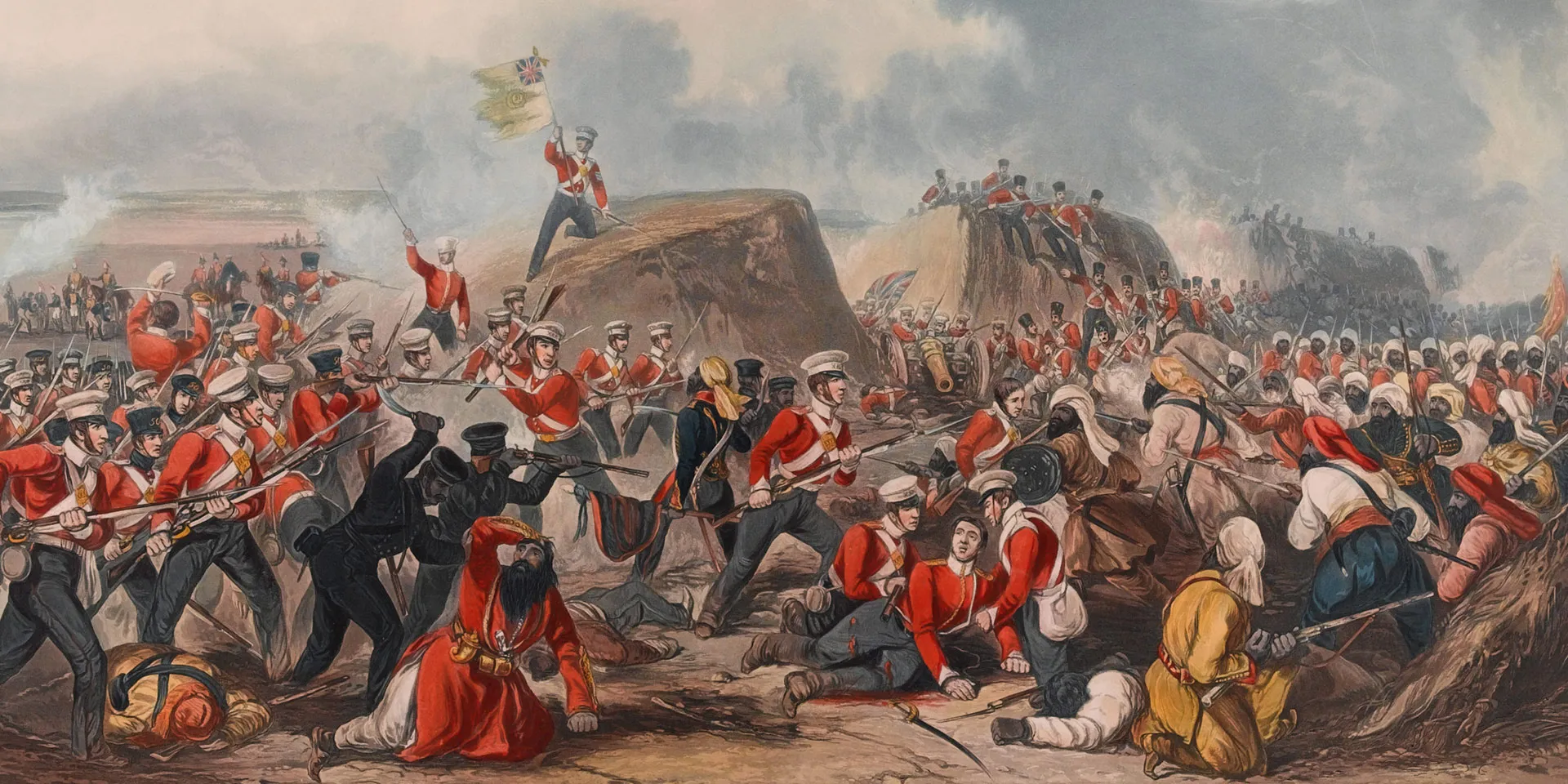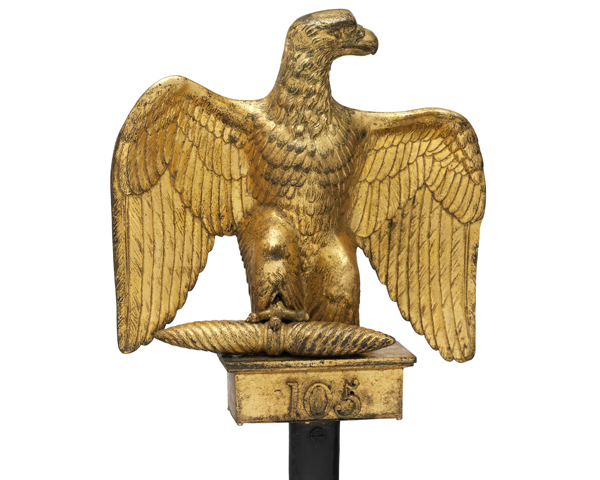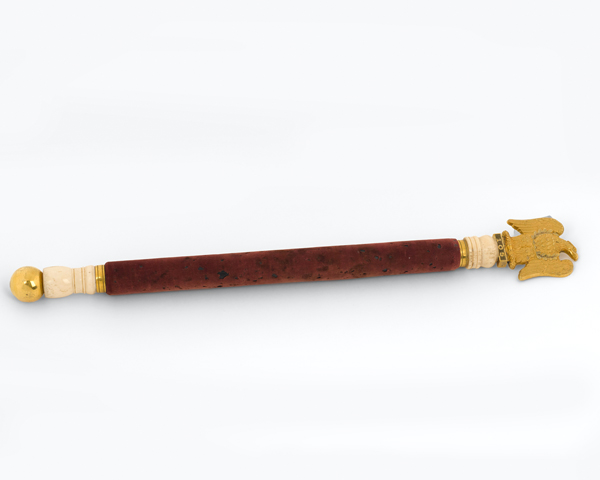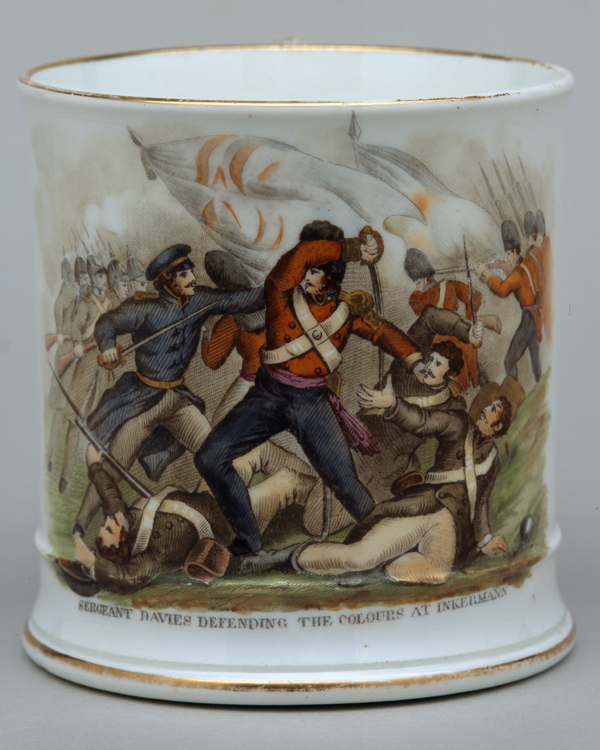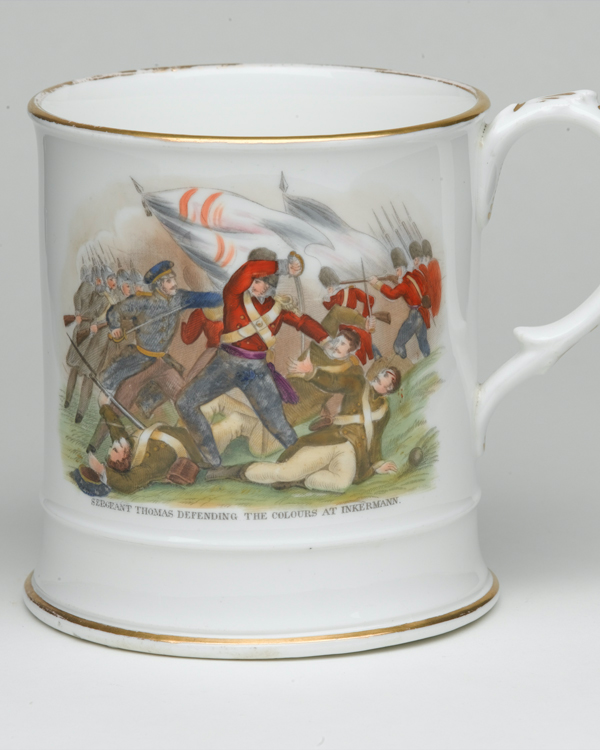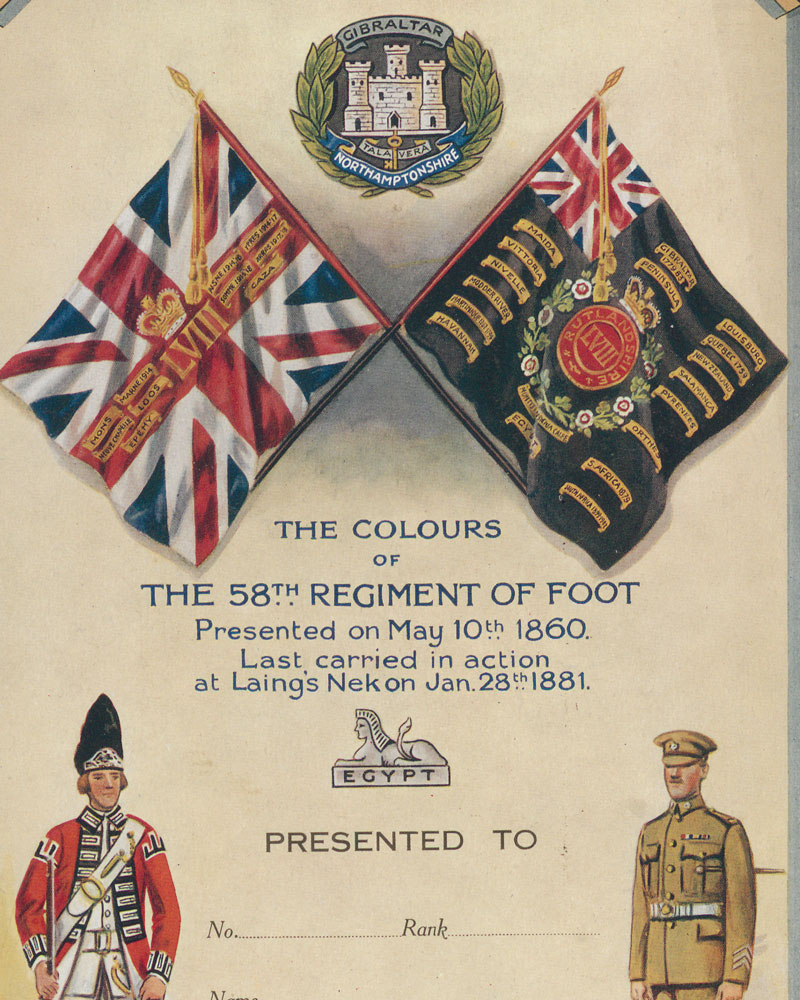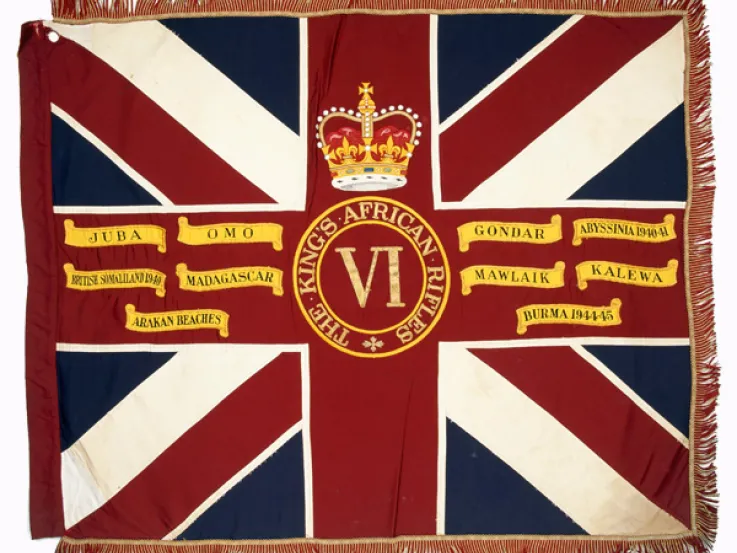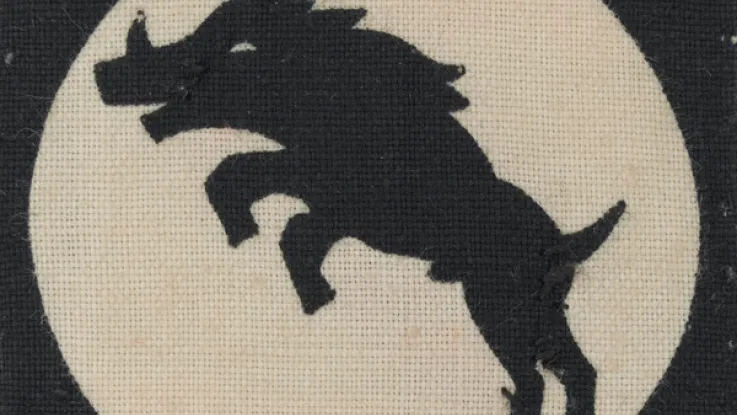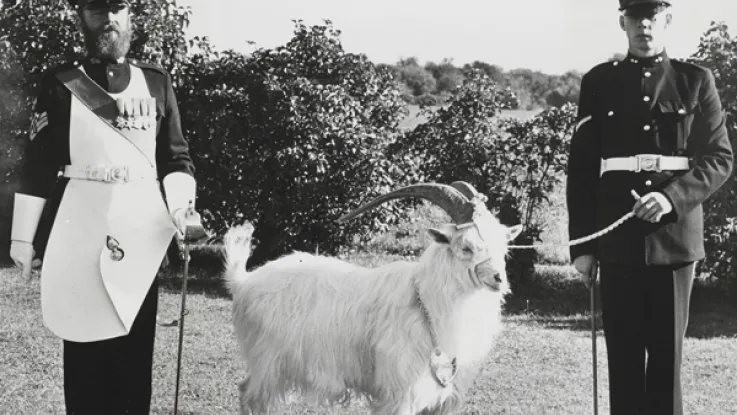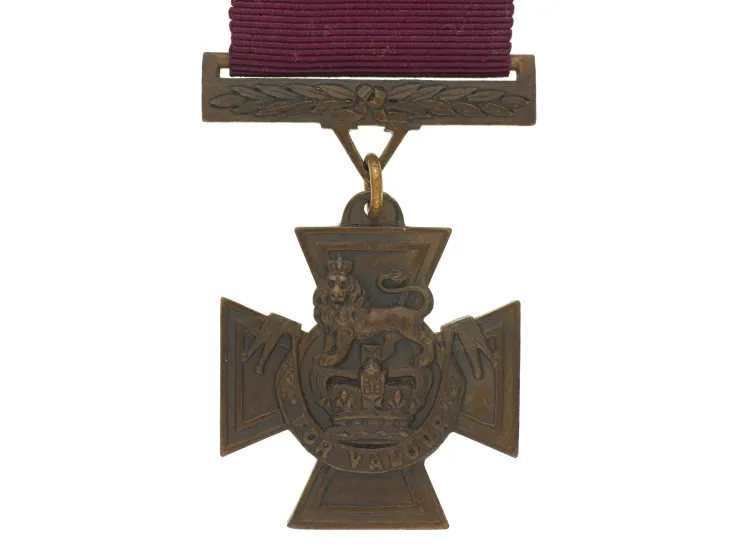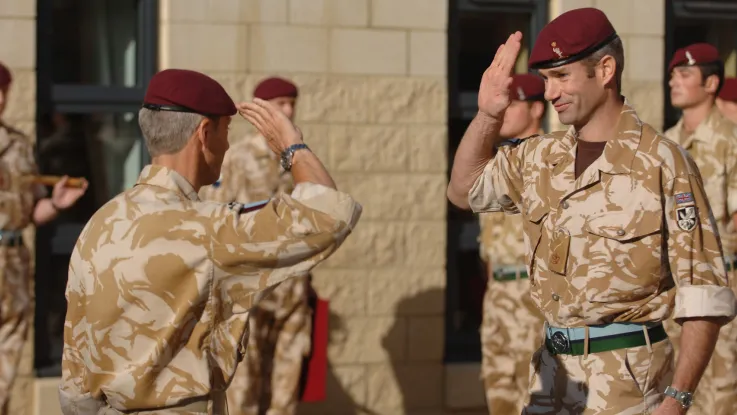Symbols
Infantry colours, and their cavalry counterparts, known as standards and guidons, are among the most sacred symbols of the British Army. These flags embody the honour, spirit and heritage of the regiments that proudly carry them.
British and Commonwealth infantry regiments usually have two colours, collectively called a stand. The King's/Queen’s Colour is typically a union flag trimmed with gold fabric, and with the regiment's insignia in the centre. It reminds all ranks of their loyalty and duty to their sovereign.
The Regimental Colour is a flag of a single colour - usually the colour of the regiment's uniform facings (collar, lapels and cuffs) - again trimmed and with the insignia in the centre. It also displays a regiment’s battle honours or those inherited from its predecessors.
'I should like to see the colours of the Regiment before I quit them for ever.’The mortally wounded Lieutenant-Colonel William Miller, 1st Regiment of Foot Guards, at Quatre Bras — 1815
Rallying point
As well as being powerful symbols of regimental history and loyalty, these flags had an important practical function in the past. On smoky, dusty and chaotic battlefields, they provided a rallying point for troops, helping to uphold both morale and command cohesion.
Losing the colours to the enemy was the greatest disgrace that could befall a regiment as it symbolised complete defeat. Correspondingly, capturing an enemy’s colours - or equivalents like eagle standards and Turkish Crescents - was among the most glorious accomplishments a soldier could achieve in battle. Many would fight ferociously, or even recklessly, to do so.
Colour guard
The task of bearing and defending the colours in battle bestowed both great honour and a heavy burden of responsibility. It was usually the most junior officers in the regiment who held this role. Their rank titles - ‘ensign’ for the infantry and ‘cornet’ for the cavalry - were derived from alternative names for these flags.
These junior officers were supported by veteran non-commissioned officers who, from the Napoleonic era onwards, held the rank of colour sergeant. Together, the group was known as the ‘colour guard’.
Given their special status, it is not surprising that colours have given rise to many incredible stories of desperate heroism, sometimes against overwhelming odds. Yet this history also includes some surprising tales of a more unusual or controversial character.
‘There had been before me that day fourteen sergeants already killed and wounded while in charge of the colours, and officers in proportion, and the staff and colours were almost cut to pieces.’Sergeant William Lawrence, 40th (2nd Somersetshire) Regiment, recounting the defence of the colours at Waterloo — 1815
Banner Royal
The first great clash of the British Civil Wars (1642-51) took place at Edgehill on 23 October 1642. During this battle, King Charles I’s ‘Banner Royal’ was both lost and recovered in heroic fashion.
The banner was borne that day by Sir Edmund Verney, the Knight Marshal. In savage close-quarter fighting, he killed two of his Parliamentary assailants before being slain, most likely by Ensign Arthur Young of Sir William Constable’s Regiment.
Verney’s gallant action became the stuff of legend. One later account stated that he had killed 16 enemies before finally succumbing. Another story has it that he was grasping the standard so tightly that his hand had to be severed before his assailants could take it away.
The banner was soon recovered for the King by Captain-Lieutenant Robert Welch and Captain John Smith. Although accounts of what happened vary, and questions remain over their respective roles, both men were knighted for their courage and were awarded medals the following year in recognition of their achievement. These were among the earliest examples of gallantry medals.
The Valiant Dragoon
A century later, the Battle of Dettingen (27 June 1743) bequeathed two more stories of courageous fighting for the colours. The first relates to Thomas Brown of the King’s Regiment of Dragoons.
Brown's unit had suffered heavy casualties and lost one of its three guidons, dropped by a wounded cornet. Seeing it on the ground, Brown dismounted to retrieve the flag, only to have two fingers cut off by a French sabre. His horse bolted, carrying him into the thick of the French lines, where he again caught sight of the guidon as it was being carried away.
Despite his injuries, he resolved to win it back. After successfully cutting down the Frenchman who bore it, he tucked the flag between his leg and saddle and fought his way back to British lines, receiving seven further wounds in the process.
Feted by his comrades, Brown was made a ‘Private gentleman in the Life Guards’. Unfortunately, his wounds soon forced him into retirement. He returned to his native Yorkshire, where he died a few years later in 1746.
Cornet Richardson
Also in the thick of the fighting at Dettingen was Ligonier’s Regiment of Horse. One of its standards was carried by Cornet Henry Richardson.
Following a desperate charge against the French line, Richardson found himself beset by the enemy. He stoutly defended the standard, receiving no fewer than 37 cuts and bullet wounds before extricating himself and his horse from the fray.
As reward for his bravery, Richardson was later presented with the battle-scarred standard. It survives to this day, and is the oldest example of a British line cavalry standard.
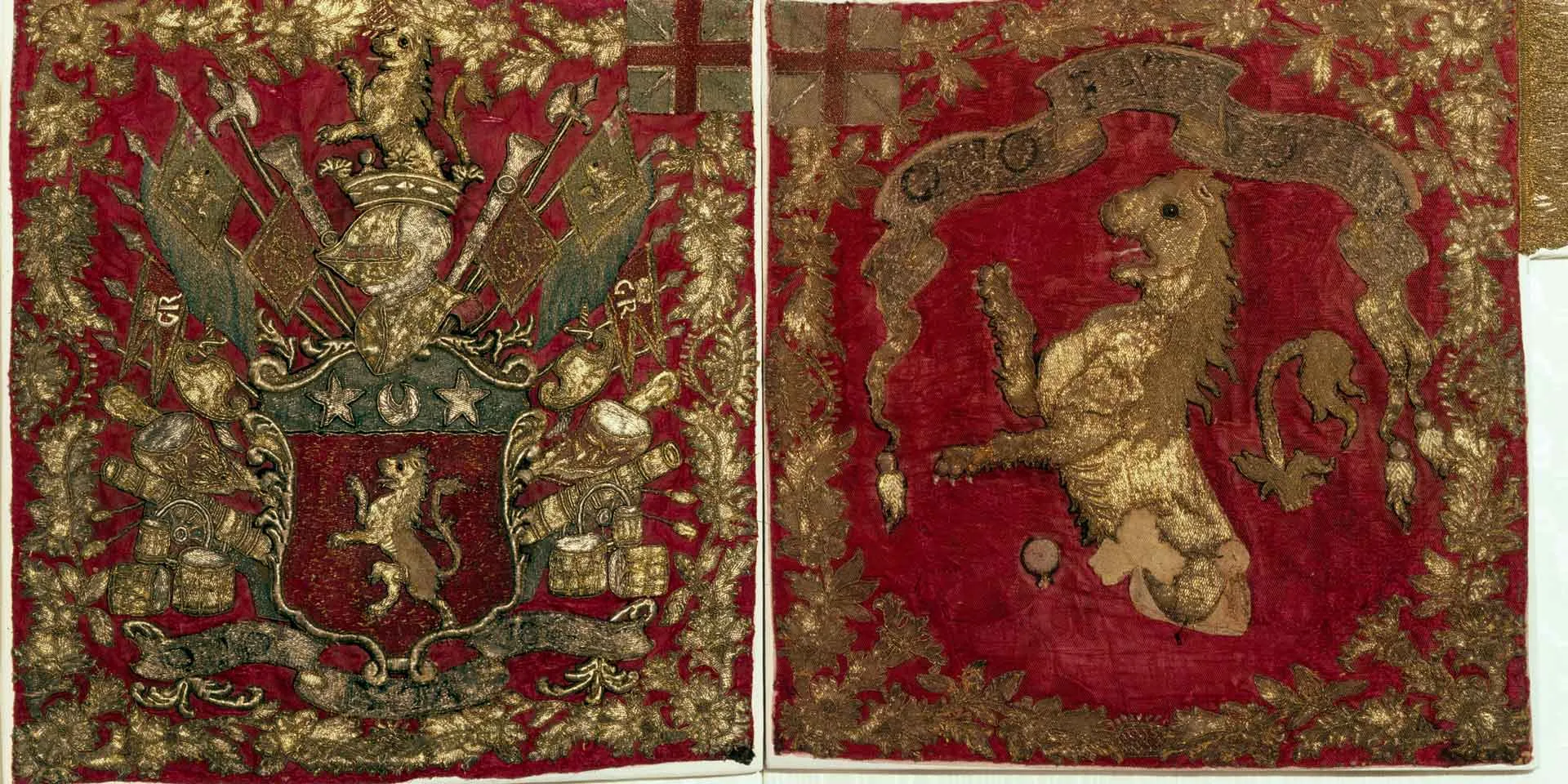
The standard of Ligonier’s Regiment of Horse saved by Cornet Richardson at Dettingen in 1743
Latham’s defiance
At the Battle of Albuera (16 May 1811) during the Peninsular War, an extraordinary struggle for the colours of the 3rd (East Kent) Regiment (The Buffs) took place after they were surrounded by French cavalry. First, their Regimental Colour was captured when its bearer, Ensign Edward Thomas, was killed. Their King’s Colour was then close to being lost when Ensign Charles Walsh was wounded.
Spotting the danger, Lieutenant Matthew Latham rushed to Walsh's aid and took up the colour, before immediately being set upon by French horsemen. He succeeded in fending them off for a time, but eventually received a heavy sword blow to the head, which cut off his nose and one side of his face. Another blow severed his left arm. But, still unbowed, Latham threw down his sword and fought on with the flagstaff in his right hand.
He was eventually overwhelmed and trampled by the surrounding cavalry, who pierced him repeatedly with their lances. As a final act before he fell, Latham tore the colour from its staff and tucked it into his jacket. Miraculously, he managed to escape death as a British counterattack eventually drove the enemy back.
Afterwards, a British soldier found his stricken body and, turning it over, recovered the flag. He assumed Latham was dead, so left him on the battlefield. Somehow, Latham later managed to crawl towards a river, where he was discovered and taken for treatment.
After his recovery, his fellow officers paid for a special gold medal to be struck in his honour. His valour even drew the attention of the Prince of Wales, who paid for a specialist surgeon to undertake work upon his mutilated face. Latham retired to France, where he lived quietly until a ripe old age.
‘I will surrender it only with my life.’Lieutenant Matthew Latham, 3rd (The East Kent) Regiment (The Buffs) at Albuera — 1811
Captured at Salamanca
The standard below is a ‘Turkish Crescent’, also known as a ‘Jingling Johnny’. It was used both as a musical instrument and a battle standard. This example was captured from the Turks by French troops while on campaign in Egypt (1798-1801). They adapted it for their own use, placing a brass Imperial Eagle on the top.
In 1812, the 88th Regiment of Foot (Connaught Rangers) captured it at Salamanca during a charge against the left wing of the French Army, the decisive action of that battle. It became one of the 88th’s most treasured relics and was always carried in front of the bands and drums on ceremonial parades by the tallest man in the regiment.
Fortune at Gandamak
One of the most remarkable stories involving the saving of a colour took place in 1842 during the disastrous British Retreat from Kabul in Afghanistan. During this grim episode, a small party from the 44th (East Essex) Regiment made a last stand on a hill at Gandamak on 13 January. Surrounded by enemies, and fearing surrender, they fought desperately to the end.
Lieutenant Thomas Souter had been protecting the Regimental Colour by wearing it under his ‘posteen’ (sheepskin coat). When the Afghans overran the hill, his posteen fell open revealing the bright yellow silk of the colour. The Afghans mistook this for the garb of an important man and took him prisoner instead of killing him - perhaps the only example of a soldier being saved by his colour.
Badly wounded, Souter was stripped of all his possessions. But the colour was later returned to him and now hangs in the Regimental Chapel at Warley.
Hidden in the Transvaal
A similar tactic was used by Colour Sergeant Maistre of the 94th Regiment of Foot during the Transvaal War (1880-81). At Bronkhorstspruit on 20 December 1880, Maistre was one of two non-commissioned officers carrying the colours when his convoy was overwhelmed by the Boers.
To prevent their capture, Maistre hid the colours in the bed of a fellow NCO's wife. When the Boers were persuaded to allow two volunteers to walk to Pretoria for medical assistance, one of them - Conductor Ralph Egerton of the Commissariat and Transport Staff - smuggled out the colours by wrapping them around his body under his clothes.
Maistre was later awarded the Distinguished Conduct Medal (DCM) for his bravery and quick thinking.
Onward to victory
While they have inspired many individual acts of heroism, the true purpose of colours was to rally and inspire regiments, or even whole armies, onward to victory. An example of this was the gallant action of Sergeant Bernard McCabe of the 31st (Huntingdonshire) Regiment at the Battle of Sobraon (10 February 1846).
After an initial assault against strong Sikh defences had been repulsed, it looked as though the battle might be lost. The 31st had suffered severe losses including both of their colour-bearing officers. Realising the danger of the situation, McCabe picked up the Regimental Colour, rushed forward and planted it squarely on the highest point on the Sikh ramparts.
Seeing this act of bravery, and their colour flying above them, the men rallied and successfully took the Sikh positions. McCabe was commissioned as a reward. He later died during the Siege of Lucknow (1857).
Eagle controversy
Not all stories relating to colours and standards are clear-cut tales of inspiration and heroism. Some have been the subject of controversy. One such story is the capture of the French 105th Regiment’s Eagle by the 1st (or Royal) Dragoons at Waterloo (18 June 1815).
This episode was marred by an argument between Lieutenant Alexander Kennedy Clark and Corporal Francis Stiles over their respective roles. Both men were at the heart of the action, but which of them actually captured the eagle was hotly disputed.
Clark described how he had killed the French standard bearer and that the eagle - which sat atop the standard - had fallen against Stiles' horse. Stiles had then taken hold of it and carried it to the rear on Clark's orders. However, Stiles claimed to have wrested the eagle from its bearer himself. He made no mention of Clark’s involvement and his story was backed up by his commanding officer, Lieutenant George Gunning.
A regimental investigation upheld Clark’s claim, but Stiles was also credited. He was promoted to sergeant and then received a commission.
An Inkerman fraud
A story from the Crimean War (1854-56) was the subject of outright fraud. Following the Battle of Inkerman (5 November 1854), Colour Sergeant Poolfield Davies took the liberty of informing the press that he had fought a valiant action to save the colours of the Grenadier Guards.
Cassell’s 'Illustrated Family History' lauded his courage, writing that: ‘Davies defended his colours with the utmost tenacity, and literally mowed down the enemy who made a rush to capture them.’ Soon after, a commemorative mug was produced to celebrate Davies’ heroism.
Yet this story was a complete fabrication. Davies had played no part in the battle at all and his disclosures to the press caused much consternation in the regiment. Eventually, the truth came out and later versions of the commemorative mug feature a Sergeant Thomas in the role instead.
Curiously, it seems unlikely that Thomas carried out this action either. However, he was presumably deemed a better choice because he had at least distinguished himself at the Alma (20 September 1854), where he had taken up the colour from a wounded officer.
‘Never mind me, save the colours.’Lieutenant Baillie to Lieutenant Peel after being wounded at Laing’s Nek — 1881
End of an era
By the 1880s, warfare had changed from traditional close-order battles fought with line and square formations towards spread-out fighting and skirmishing in which troops moved freely and took cover. This meant that the colours were becoming a liability rather than an asset.
This was vividly illustrated at the Battle of Laing’s Nek (28 January 1881), during the Transvaal War (1880-81). The Boers took up a formidable hilltop position and succeeded in inflicting a stinging defeat upon a British attacking force. The 58th (Rutlandshire) Regiment suffered particularly severely, losing 74 dead and 101 wounded, including their two commanding officers.
Their colours were borne that day by Lieutenants Lancelot Baillie and WE Peel. In the course of the attack, Baillie was seriously wounded by a bullet. Peel went to his assistance and then continued to advance, carrying both colours, until he tripped on an aardvark hole. Thinking Peel had been shot, Sergeant Bridgestock, took up the colours and brought them back to Lieutenant Wallace who carried them to the rear.
Lieutenant Alan Hill vainly attempted to save the life of Lieutenant Baillie, who was shot again while being carried to safety. This was one of several brave deeds that earned Hill the Victoria Cross.
This gallant action brought to a close a glorious chapter in military history. Laing’s Nek was the last time that colours were ever carried into battle by a British regiment.

